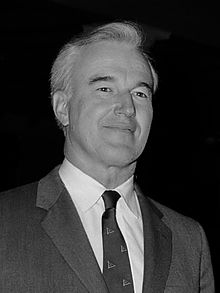Britton Chance
| Britton Chance | |
|---|---|

Britton Chance (Ron Kroon, 1965)
|
|
| Born |
July 24, 1913 Wilkes-Barre, Pennsylvania |
| Died | November 16, 2010 (aged 97) Philadelphia, Pennsylvania |
| Nationality | United States |
| Fields |
Biophysics Biochemistry |
| Institutions | University of Pennsylvania |
| Alma mater |
University of Pennsylvania (B.A) (1935) University of Pennsylvania (M.A.) (1936) University of Pennsylvania (Ph.D) (1940) Cambridge University (Ph.D) (1942) |
| Known for |
Enzyme kinetics Optical imaging MRI |
| Olympic medal record | ||
|---|---|---|
| Men's sailing | ||
| Representing the |
||
| Helsinki 1952 | 5.5 metre class | |
| World Championships | ||
| 1962 Poole | 5.5m | |
Britton Chance (July 24, 1913 – November 16, 2010) was the Eldridge Reeves Johnson University Professor Emeritus of Biochemistry and Biophysics, as well as Professor Emeritus of Physical Chemistry and Radiological Physics at the University of Pennsylvania School of Medicine.
At the 1952 Summer Olympics, Chance won a gold medal in sailing.
Chance was born in Wilkes-Barre, Pennsylvania. He received a B.A. (1935), M.A. (1936), and Ph.D. degree in Physical Chemistry (1940) at the University of Pennsylvania, where he was a member of St. Anthony Hall.
Chance earned a second Ph.D. at Cambridge University in 1942 in Biology/Physiology.
During World War II, Chance worked for the Radiation Laboratory at the Massachusetts Institute of Technology which was working on the development of radar. In 1952, he received his D.Sc. from Cambridge.
His research interests were diverse. He was promoted as the Professor of Biophysics at the University of Pennsylvania School of Medicine and appointed the second director of the Johnson Foundation, a position he held until 1983. He was then appointed E. R. Johnson Professor of Biophysics and Physical Biochemistry (later renamed as Biochemistry and Biophysics) in 1964 and University Professor in 1977.
In his early career, he was mainly working on enzyme structure and function. He had invented the now standard stopped-flow device to measure the existence of the enzyme-substrate complex in enzyme reaction. He was a pioneer in the numerical simulations of biochemical reactions and metabolic pathways.
...
Wikipedia
